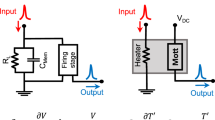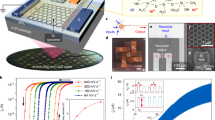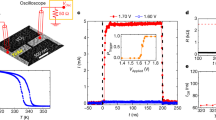Abstract
The Hodgkin–Huxley model for action potential generation in biological axons1 is central for understanding the computational capability of the nervous system and emulating its functionality. Owing to the historical success of silicon complementary metal-oxide-semiconductors, spike-based computing is primarily confined to software simulations2,3,4 and specialized analogue metal–oxide–semiconductor field-effect transistor circuits5,6,7,8. However, there is interest in constructing physical systems that emulate biological functionality more directly, with the goal of improving efficiency and scale. The neuristor9 was proposed as an electronic device with properties similar to the Hodgkin–Huxley axon, but previous implementations were not scalable10,11,12,13. Here we demonstrate a neuristor built using two nanoscale Mott memristors, dynamical devices that exhibit transient memory and negative differential resistance arising from an insulating-to-conducting phase transition driven by Joule heating. This neuristor exhibits the important neural functions of all-or-nothing spiking with signal gain and diverse periodic spiking, using materials and structures that are amenable to extremely high-density integration with or without silicon transistors.
This is a preview of subscription content, access via your institution
Access options
Subscribe to this journal
Receive 12 print issues and online access
$259.00 per year
only $21.58 per issue
Buy this article
- Purchase on Springer Link
- Instant access to full article PDF
Prices may be subject to local taxes which are calculated during checkout



Similar content being viewed by others
References
Hodgkin, A. L. & Huxley, A. F. A quantitative description of membrane current and its application to conduction and excitation in nerve. J. Physiol. 117, 500–544 (1952).
Herz, A. V. M., Gollisch, T., Machens, C. K. & Jaeger, D. Modeling single-neuron dynamics and computations: A balance of detail and abstraction. Science 314, 80–85 (2006).
O’Reilly, R. C. Biologically based computational models of high-level cognition. Science 314, 91–94 (2006).
Izhikevich, E. M. Hybrid spiking models. Phil. Tran. R. Soc. A 368, 5061–5070 (2010).
Mead, C. Analog VLSI and Neural Systems (Addison-Wesley, 1989).
Rachmuth, G. & Poon, C. S. Transistor analogs of emergent iono-neuronal dynamics. HFSP J. 2, 156–166 (2008).
Brüderle, D. et al. A comprehensive workflow for general-purpose neural modeling with highly configurable neuromorphic hardware systems. Biol. Cybernet. 104, 263–296 (2011).
Arthur, J. V. & Boahen, K. A. Silicon-neuron design: A dynamical systems approach. IEEE Trans. Circuits Syst. I 58, 1034–1043 (2011).
Crane, H. D. The neuristor. IRE Trans. Elect. Comput. 9, 370–371 (1960).
Cote, A. J. A neuristor prototype. Proc. IRE 49, 1430–1431 (1961).
Nagumo, J., Arimoto, S. & Yoshizawa, S. An active pulse transmission line simulating nerve axon. Proc. IRE 50, 2061–2070 (1962).
FitzHugh, R. Impulses and physiological states in theoretical models of nerve membrane. Biophys. J. 1, 445–466 (1961).
Nishizawa, J-I. & Hayasaka, A. Two-line neuristor with active element in series and in parallel†. Int. J. Electr. 26, 437–469 (1969).
McCulloch, W. S. & Pitts, W. A logical calculus of the ideas immanent in nervous activity. Bull. Math. Biophys. 5, 115–133 (1943).
Chua, L. & Kang, S. Memristive devices and systems. Proc. IEEE 64, 209–223 (1976).
Chua, L., Sbitnev, V. & Kim, H. Hodgkin–Huxley axon is made of memristors. Int. J. Bifur. Chaos 22, 1–48 (2012).
Chua, L. O. Local activity is the origin of complexity. Int. J. Bifur. Chaos Appl. Sci. Eng. 15, 3435–3456 (2005).
Chudnovskii, F. A., Odynets, L. L., Pergament, A. L. & Stefanovich, G. B. Electroforming and switching in oxides of transition metals: The role of metal–insulator transition in the switching mechanism. J. Solid State Chem. 122, 95–99 (1996).
Chopra, K. L. Current-controlled negative resistance in thin niobium oxide films. Proc. IEEE 51, 941–942 (1963).
Geppert, D. V. A new negative-resistance device. Proc. IEEE 51, 223–223 (1963).
Pickett, M. D., Borghetti, J., Yang, J. J., Medeiros-Ribeiro, G. & Williams, R. S. Coexistence of memristance and negative differential resistance in a nanoscale metal-oxide-metal system. Adv. Mater. 23, 1730–1733 (2011).
Pickett, M. D. & Williams, R. S. Sub-100 femtoJoule and sub-nanosecond thermally-driven threshold switching in niobium oxide crosspoint nanodevices. Nanotechnology 23, 215202 (2012).
Ielmini, D. Threshold switching mechanism by high-field energy gain in the hopping transport of chalcogenide glasses. Phys. Rev. B 78, 035308 (2008).
Pearson, S. O. & Anson, H. S. G. Demonstration of some electrical properties of neon-filled lamps. Proc. Phys. Soc. Lond. 34, 175 (1921).
Connors, B. W. & Gutnick, M. J. Intrinsic firing patterns of diverse neocortical neurons. Trends Neurosci. 13, 99–104 (1990).
Izhikevich, E. M. Simple model of spiking neurons. IEEE Trans. Neural Net. 14, 1569–1572 (2003).
Chua, L. O. & Yang, L. Cellular neural networks: Applications. IEEE Trans. Circuits Syst. 35, 1273–1290 (1988).
Wilamowski, B. M. A novel concept of neuristor logic. Int. J. Electron. 33, 659–663 (1972).
Izhikevich, E. M. & Hoppensteadt, F. C. Polychronous wavefront computations. Int. J. Bifur. Chaos 19, 1733–1739 (2009).
Snider, G. S. Self-organized computation with unreliable, memristive nanodevices. Nanotechnology 18, 365202 (2007).
Choi, H. et al. An electrically modifiable synapse array of resistive switching memory. Nanotechnology 20, 345201 (2009).
Pershin, Y. V. & Ventra, M. D. Experimental demonstration of associative memory with memristive neural networks. Neural Netw. 23, 881–886 (2010).
Acknowledgements
We acknowledge J. Borghetti for seeding important discussions on biological oscillators with the authors; X. Li, C. Le and T. Ha for fabrication and laboratory support; and J. P. Strachan for review and discussion of the manuscript.
Author information
Authors and Affiliations
Contributions
M.D.P. conceived, simulated, fabricated and tested the neuristor described in this work. R.S.W. guided the work and provided critical insight. G.M-R. provided discussion and analysis of results and essential management support. M.D.P. and R.S.W. wrote the manuscript.
Corresponding author
Ethics declarations
Competing interests
The authors declare no competing financial interests.
Supplementary information
Supplementary Information
Supplementary Information (PDF 664 kb)
Supplementary Information
Supplementary Movie S1 (MP4 99 kb)
Rights and permissions
About this article
Cite this article
Pickett, M., Medeiros-Ribeiro, G. & Williams, R. A scalable neuristor built with Mott memristors. Nature Mater 12, 114–117 (2013). https://doi.org/10.1038/nmat3510
Received:
Accepted:
Published:
Issue Date:
DOI: https://doi.org/10.1038/nmat3510
This article is cited by
-
VO2 memristor-based frequency converter with in-situ synthesize and mix for wireless internet-of-things
Nature Communications (2024)
-
Chalcogenide Ovonic Threshold Switching Selector
Nano-Micro Letters (2024)
-
A neuromorphic physiological signal processing system based on VO2 memristor for next-generation human-machine interface
Nature Communications (2023)
-
Resistive switching and battery-like characteristics in highly transparent Ta2O5/ITO thin-films
Scientific Reports (2023)
-
Ion-tunable antiambipolarity in mixed ion–electron conducting polymers enables biorealistic organic electrochemical neurons
Nature Materials (2023)



